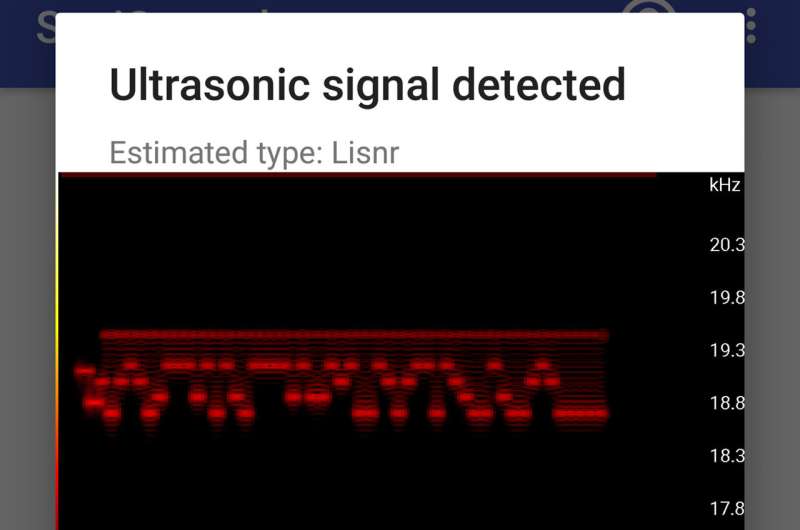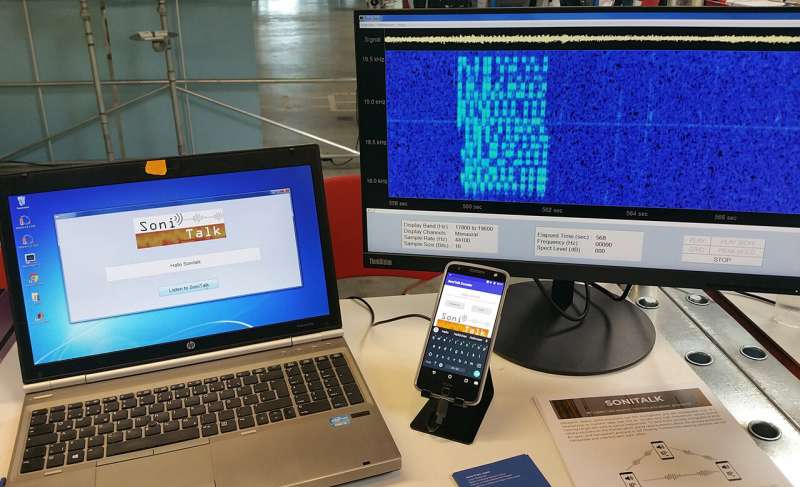Secure data transmission with ultrasound on the mobile phone

Ultrasound communication is an entirely new method for data exchange between IoT devices and mobile phones. The communication between these is inaudible and the hardware requirements are kept to a minimum: microphone and loudspeakers. Researchers of the St. Pölten University of Applied Sciences have now developed a first open communication protocol including an open-source development kit for ultrasound communication by the name of SoniTalk.
The technology is available for free and—contrary to similar technologies—focuses on security and data protection. In this way, SoniTalk leaves it up to the users to decide which apps and devices are allowed to communicate via ultrasound, and in which cases.
Conected devices
The networking of devices in everyday life and in companies is increasing steadily. So far, ultrasound communication has received little attention, although it is a promising technology for ad-hoc data exchange and near-field communication and presents a channel for the secure authentication of devices and persons.
"Individual companies have already developed approaches to ultrasound communication but the technologies are subject to the copyright of these businesses and some of them raise questions concerning the protection of the users' privacy. This is why an open protocol was urgently needed in order to guarantee secure communication and protect privacy," explains Matthias Zeppelzauer, Senior Researcher at the Institute of CreativeMedia/Technologies at the St. Pölten UAS.

Freely Available Technology and Improved Data Protection
Together with his colleagues Alexis Ringot and Florian Taurer, Zeppelzauer developed such an open and transparent communication protocol for data transmission using ultrasound (Data Over Sound). SoniTalk is freely available as an open-source technology. The development kit of the same name underlying the software was implemented using Java for Android and makes it possible to send and receive any data in the ultrasound frequency range. SoniTalk thus represents an inexpensive alternative to Bluetooth and other radio-based communication technologies such as RFID (radio-frequency identification) and NFC (near-field communication).
"We developed SoniTalk in accordance with the 'privacy-by-design' principle. This means that mechanisms for privacy protection were taken into account early on in the design of the system. Users of SoniTalk retain complete control over which app is allowed to send which content, which helps them protect their own privacy," describes Zeppelzauer.
Precursor Project Ultrasound Firewall and Legal Considerations
Through the so-called audiotracking, mobile phones and tablets can use ultrasound to track the users' behaviour unnoticed—such as which videos they watch or their whereabouts. Last year in the spring, Zeppelzauer and his colleagues published their app SoniControl which can block acoustic tracking. They are currently further developing the app in order to make it even more attractive to users. It is supposed to be integrated into the SoniTalk protocol in the future to guarantee secure data transmission there.
Following the publication of SoniControl, two legal experts from Vienna specialising in data protection and IT carried out a legal assessment for this form of tracking and called for more transparency in dealing with the new technology. According to them, the explicit consent of the users to data transmission via ultrasound is an essential element—SoniTalk and its underlying technological protocol now solve this issue.
Companies Wanted: Benefit for Industry, Art and Everyday Life
SoniTalk enables new functions and services for the digitalisation: for example, SoniTalk could be used to authenticate and verify data and persons, to track objects in production (asset tracking), the set up local networks (ad-hoc networks), for mobile payment and money transfer, the pairing of devices, and the control of smart homes.
In the near future, SoniTalk is supposed to be practice-tested in its first Industry 4.0 applications. For this purpose, Matthias Zeppelzauer and his colleagues are currently developing a suitable ultrasound beacon (a type of loudspeaker) for location-dependent services on the basis of SoniTalk. This beacon is then supposed to be made available as free and open-format hardware.
According to Zeppelzauer, the target group includes companies and persons in the IT sector and Industry 4.0, providers of indoor navigation systems and cashless/contactless payment systems, artists and museums wishing to design interactive exhibitions, and the open-source community.
As the new technology is available as an open-source system, interested parties, developers and companies can adapt and improve it as needed. The researchers of the St. Pölten UAS are also planning to further develop the technology behind SoniTalk and are currently searching for companies looking to gain an advantage through the new technology.
More information:
sonitalk.fhstp.ac.at/
www.netidee.at/sonitalk





















